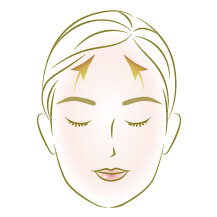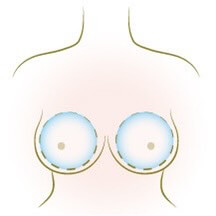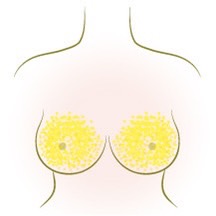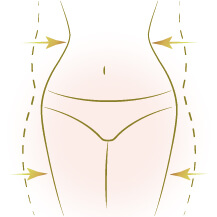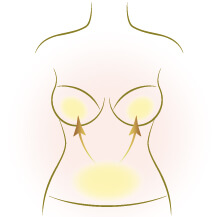Eye Surgery
Ptosis and Levator Muscle Surgery
BLEPHAROPLASTY
BLEPHAROPLASTY
Ptosis and Levator
Muscle Surgery
- Principle
- Before and After
- Case Study
The levator muscle is a muscle that helps us to open our eyes. Between it and the tarsal plate, there is a thin layer of fascia (also known as an aponeurosis or tendon) that connects them. When we open our eyes, the linked fascia is driven, the eyelid plate of the upper eyelid is dragged up, and the upper eyelid is pulled up to open the upper eyelid. This is accomplished by the contraction of the levator muscle. When the upper eyelid opens normally, it covers the upper edge of the black eyeball to a height of roughly 1-2 mm (Figure 1, right eye).
Blepharoptosis, which causes the upper eyelid to cover too many black eyeballs and seem dull, occurs when the upper eyelid’s opening function deteriorates (Figure 1, left eye). If the coverage is 2-3mm or more, the appearance will be very drab, and some patients may even cause the pupil to close, impairing vision.
Blepharoptosis, which causes the upper eyelid to cover too many black eyeballs and seem dull, occurs when the upper eyelid’s opening function deteriorates (Figure 1, left eye). If the coverage is 2-3mm or more, the appearance will be very drab, and some patients may even cause the pupil to close, impairing vision.

圖一
Putterman AM, Urist MJ. Müller muscle-conjunctiva resection. Technique for treatment of blepharoptosis. Arch Ophthalmol 1975;93:619–23.
Causes of Blepharoptosis:
1.Levator Apnurosis Dehiscence, Disinsertion, or Stretching: the most common cause of ptosis! Most patients fall into this group, primarily as a result of age, as a result of the more than ten thousand times each day that human eyes open and close causing fascia (also known as an aponeurosis or tendon) to relax or separate from the tarsal plate.
2.Levator muscle weakness: It can be congenital or acquired, and the possible causes are myasthenia gravis, brain injury, cranial nerve injury (third pair CNIII), spinal cord injury (T1), eyelid trauma, cut muscle, etc.
3.Mechanical ptosis: eyelid tumor, swollen eye of the needle…etc, ptosis caused by gravity
4.Pseudo-ptosis: The upper eyelid is too loose and sagging to cover the dark eyeballs, and the eyelid position is normal
2.Levator muscle weakness: It can be congenital or acquired, and the possible causes are myasthenia gravis, brain injury, cranial nerve injury (third pair CNIII), spinal cord injury (T1), eyelid trauma, cut muscle, etc.
3.Mechanical ptosis: eyelid tumor, swollen eye of the needle…etc, ptosis caused by gravity
4.Pseudo-ptosis: The upper eyelid is too loose and sagging to cover the dark eyeballs, and the eyelid position is normal
| Ptosis Causes | Levator Apnurosis Dehiscence, Disinsertion, or Stretching | Levator Muscle Weakness | Mechanical Ptosis | Pseudoptosis |
|---|---|---|---|---|
| Treatment | 1.Fascia preposition 2.Fascial Folds | Treatment according to the cause of muscle weakness: 1. Treat Myasthenia Gravis 2. Neurological rehabilitation 3. Müllerian muscle resection 4. Eyelid muscle trauma Suture 5. Frontalis suspension surgery: used when the levator muscle function is too poor (<5mm) | 1. to remove the tumor, 2. Treating the eye of acupuncture | 1. Raise eyebrows 2. Cut off the droopy upper eyelid 3. Fold the droopy skin over the sutured double eyelid |
According to the many reasons of eyelid ptosis, there are several treatment options. Before surgery, the patient must get a thorough examination, communivate with the surgeon, and have the underlying issue treated.
Levator Muscle Surgery:
It includes a variety of surgical procedures for both internal and exterior openings to treat ptosis. Different surgeons each have their own familiar, specialized techniques. Here, I’ll primarily discuss my surgical techniques and patient-care experience.
1. Levator advancement and fold (Plication) surgery:
According to the doctor’s experience, most of the patients with poor upper eyelid opening function are caused by the aging and relaxation of the fascia. A wound of about 3-4 cm is incised just above the predetermined double eyelid crease. The fascia is advanced and fixed on the eyelid plate to correct the ptosis of the upper eyelid, which is called levator advancement surgery; Patients with ptosis and bilateral eyelid height asymmetry (large and small eyes). For a few suitable patients, the levator myofascial fold (Plication) surgery can be folded & prepositioned by transconjunctival or suture. called levator advancement; or folding the levator fascia.

2. Frontalis Sling Surgery
The upper eyelid cannot be pulled at all or only partially if the levator muscle is not functioning properly (5mm). The lateral thigh muscle fascia or an external fascia can be employed to elevate the upper eyelid at this point by contracting the muscles of the forehead. The frontalis muscle is suspended from the top eyelid plate by a graft (silicone tube) known as the frontalis sling. The frontalis muscle flap is sometimes used for suspension. The Frontalis sling’s drawback is that it adds three tiny wounds to the brows, which could lead to inadequate eye closure and injury to the forehead branch of the supraframe nerve.

Reference: Chen, Y., Weber, A.C., Marx, D.P., Allen, R.C., Levine, M.R. (2018). Frontalis Sling. In: Levine, M., Allen, R. (eds) Manual of Oculoplastic Surgery. Springer, Cham. https://doi.org/10.1007/978-3-319-74512-1_18
3. Müllerian Muscle Resection
A part of the conjunctiva along with the underlying Müllerian muscle is removed and sutured through the conjunctiva, and it is completed. The procedure is very simple and quick and can improve (1-2mm) mild upper eyelid ptosis.

Reference: Allen M. Putterman, Steven Fagien; chapter 11, Müller’s Muscle–Conjunctival Resection–Ptosis Procedure Combined with Upper Blepharoplasty; Puttermans Cosmetic Oculoplastic Surgery E-Book
| Surgical Methods | Levator advancement and fold (Plication) surgery | Frontalis Sling Surgery | Müllerian Muscle Resection |
|---|---|---|---|
| Suitable Candidate | Asymmetry in the height of the eyelids on either side (big and small eyes),sagging eyelids,suitable for patients with levator muscle function that is generally normal | Bilateral eyelid height asymmetry (big and small eyes),drooping eyelids,Suitable for patients with levator muscle function <5mm | Bilateral eyelid height asymmetry (big and small eyes) ptosis Spinal cord injury (T1) |
| Surgery Time | 1-2 hours | 1-2 hours | 1 hours |
| Anesthesia Method | Local anesthesia | Local anesthesia | Local anesthesia |
| Pros | Completely solve the problem of ptosis through the upper eyelid crease incision,Adjust eye shape | Eyelid lift with frontalis muscle strength | Simple and fast, fast recovery, no incision above the eyelid |
| Cons | Difficult to rebuild and longer recovery period | 3 small incisions are required on the eyebrows, Autologous fascia or extracorporeal graft (silicone tube) required, Difficult to rebuild and longer recovery period | The eyelid lift is limited (about 1-2mm) |
| Recovery Period | 7-14 days | 7-14 days | 7 days |
| Close to Natural Look | 2-3 months or above | 2-3 months or above | 1 month |
"Surgical comparison" is Dr. Chen's experience in treating patients. The above methods all require full communication between the patient and the doctor to discuss the most suitable surgical method for the patient.
Preoperative Preparation and Anesthesia
1.Before surgery, please let your doctor know if you have any drug
allergies.
2.Anticoagulant medication must be stopped one week before to surgery in order to prevent intraoperative and postoperative bleeding.
3.Smoking should be avoided for at least two weeks before to and following surgery.
4.It is advised that medical professionals regulate and stabilize systemic disorders such as excessive blood pressure, heart disease, diabetes, abnormal thyroid function, etc. before undergoing surgery.
5.Please let your doctor know before surgery if you or anybody in your family has swollen feet or hypertrophic scars.
6.Because the patient’s eyes must frequently cooperate during the procedure to ensure precise symmetry, it is advised to do eyelid surgery while the patient is under local anesthetic.
2.Anticoagulant medication must be stopped one week before to surgery in order to prevent intraoperative and postoperative bleeding.
3.Smoking should be avoided for at least two weeks before to and following surgery.
4.It is advised that medical professionals regulate and stabilize systemic disorders such as excessive blood pressure, heart disease, diabetes, abnormal thyroid function, etc. before undergoing surgery.
5.Please let your doctor know before surgery if you or anybody in your family has swollen feet or hypertrophic scars.
6.Because the patient’s eyes must frequently cooperate during the procedure to ensure precise symmetry, it is advised to do eyelid surgery while the patient is under local anesthetic.
Recovery process and post-operative care
1.To lessen discomfort and bruising, it is advised to apply ice for 10
minutes every hour for the first 5-7 days following eyelid surgery.
2.For three days following surgery, prophylactic oral antibiotics, anti-inflammatory, analgesic, detumescence, and other medications will be administered.
3.To replace the dressing, eye ointment will be prescribed by eyelid wound care. Once each in the morning and evening, change your clothes. Clean the site with normal saline or boiled water, remove any scabs or secretions, and then apply fresh ointment.
4.A week following the procedure, the sutures will be taken out.
5.It is advised to warm the skin (to the temperature of face wash water in the morning in winter) for 10 minutes every hour after the stitches are removed to hasten the healing of bruises.
6.Each person’s level of postoperative swelling and bruising is different. It usually becomes apparent three to four days following surgery, and most people can feel better approximately two weeks later.
7.After the procedure, you can wash your face as usual, take a bath, dry your skin right away, and then apply the ointment. But refrain from swimming, wading in the stream alongside the sea, and taking a dip in the hot springs.
8.After surgery, stay away from strenuous activities like hard training, running, mountaineering, rock climbing, etc. It may raise blood pressure, result in bleeding, or leave wounds open.
9.The diet is generally healthy, but stay away from alcohol, smoke, and spicy food (too spicy and salty)
2.For three days following surgery, prophylactic oral antibiotics, anti-inflammatory, analgesic, detumescence, and other medications will be administered.
3.To replace the dressing, eye ointment will be prescribed by eyelid wound care. Once each in the morning and evening, change your clothes. Clean the site with normal saline or boiled water, remove any scabs or secretions, and then apply fresh ointment.
4.A week following the procedure, the sutures will be taken out.
5.It is advised to warm the skin (to the temperature of face wash water in the morning in winter) for 10 minutes every hour after the stitches are removed to hasten the healing of bruises.
6.Each person’s level of postoperative swelling and bruising is different. It usually becomes apparent three to four days following surgery, and most people can feel better approximately two weeks later.
7.After the procedure, you can wash your face as usual, take a bath, dry your skin right away, and then apply the ointment. But refrain from swimming, wading in the stream alongside the sea, and taking a dip in the hot springs.
8.After surgery, stay away from strenuous activities like hard training, running, mountaineering, rock climbing, etc. It may raise blood pressure, result in bleeding, or leave wounds open.
9.The diet is generally healthy, but stay away from alcohol, smoke, and spicy food (too spicy and salty)
Sequelae and Complications
1.Asymmetry is the most frequent side effect of eyelid surgery, and
some individuals require revision surgery.
2.There is a danger of infection, hemorrhage, inadequate wound healing, etc. with any operation.
3.Although all surgeries leave scars, the plastic surgeon will meticulously stitch and use extremely thin sutures to tuck the scars into the creases of the skin and the borders of the hair, making them less noticeable and more difficult to locate. Even so, the scar may still be momentarily red and elevated (1-2 months after the operation) until it stabilizes, but after two to six months the scar will often gradually fade and become less noticeable.
2.There is a danger of infection, hemorrhage, inadequate wound healing, etc. with any operation.
3.Although all surgeries leave scars, the plastic surgeon will meticulously stitch and use extremely thin sutures to tuck the scars into the creases of the skin and the borders of the hair, making them less noticeable and more difficult to locate. Even so, the scar may still be momentarily red and elevated (1-2 months after the operation) until it stabilizes, but after two to six months the scar will often gradually fade and become less noticeable.







